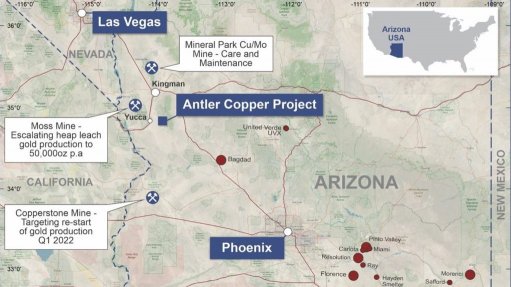Green hydrogen has significant growth potential as a zero-carbon fuel, says the WPIC
Energy company Siemens Gas and Power estimates that, by 2050, hydrogen demand will have risen to over 450 megatons a year, be dominated by green hydrogen and be essential to achieving global decarbonisation.
Hydrogen demand is currently at between 70 and 80 megatons a year and over 90% of hydrogen production is currently derived from fossil fuels, mainly natural gas.
The scale of growth expected up to 2050 ensures that a range of technologies will be employed to achieve the most cost- and carbon dioxide-effective solutions, the World Platinum Investment Council (WPIC) says.
In response to this, Siemens has signed a cooperation agreement with global energy company Uniper to develop projects aimed at the decarbonisation of Uniper’s power generation activities.
The collaboration is focused on the promotion of sector coupling, addressing the entire value chain and looking at the energy, mobility and industry sectors together. The partners will also consider the feasibility of repurposing Uniper’s existing gas turbines and gas storage facilities for the use of hydrogen.
The WPIC says platinum-based proton exchange membrane electrolysis can produce green hydrogen from renewable energy sources, enhancing grid stability and power storage, bringing about sustainable and dependable power sector transformation.
This is just one aspect of the transformative power of green hydrogen, the WPIC says, adding that it is a carbon-free fuel which, according to Siemens Mobility, is the “oil of the future”, produced through the electrolysis of water using electricity from renewable sources, typically wind and solar.
As an energy carrier, green hydrogen enables “sector coupling”, allowing decarbonisation of the wider economy through the integration of renewable power generation with consumers of energy providing the medium by which renewable energy is transferred across the supply chain, displacing fossil fuels.
Crucially, green hydrogen overcomes constraints such as proximity to renewable infrastructure, delivering the emissions-free benefits of renewable energy beyond traditional hubs.
The WPIC notes that even hard-to-abate industries, such as heavy industry and heavy transport which account for about 40% of total carbon emissions and where direct electrification or battery technology is not optimal, can benefit.
“Effectively, through green hydrogen, excess renewable energy can be harnessed and supplied to end-users, for example to be used in refuelling networks for fuel cell electric vehicles,” the WPIC says.
Green hydrogen, meanwhile, has the potential to become a global commodity that is traded in much the same way as oil and gas is today. However, the WPIC said that this depends on the availability of the necessary, scalable infrastructure to store and transport it.
While scope exists to use existing gas networks, projects involving new hydrogen pipeline systems are already under way, with a major initiative in the North Sea highlighting how sector coupling might be achieved by building-out across the hydrogen value chain, from the production of green hydrogen using offshore wind energy, to its transportation via a new pipeline to consumers on shore in mainland Germany and beyond.
The plan is to create 10 GW of generation capacity by 2035, enough to produce up to one-million tonnes of green hydrogen a year, making a substantial contribution to the decarbonisation of energy supply in Europe.
Comments
Press Office
Announcements
What's On
Subscribe to improve your user experience...
Option 1 (equivalent of R125 a month):
Receive a weekly copy of Creamer Media's Engineering News & Mining Weekly magazine
(print copy for those in South Africa and e-magazine for those outside of South Africa)
Receive daily email newsletters
Access to full search results
Access archive of magazine back copies
Access to Projects in Progress
Access to ONE Research Report of your choice in PDF format
Option 2 (equivalent of R375 a month):
All benefits from Option 1
PLUS
Access to Creamer Media's Research Channel Africa for ALL Research Reports, in PDF format, on various industrial and mining sectors
including Electricity; Water; Energy Transition; Hydrogen; Roads, Rail and Ports; Coal; Gold; Platinum; Battery Metals; etc.
Already a subscriber?
Forgotten your password?
Receive weekly copy of Creamer Media's Engineering News & Mining Weekly magazine (print copy for those in South Africa and e-magazine for those outside of South Africa)
➕
Recieve daily email newsletters
➕
Access to full search results
➕
Access archive of magazine back copies
➕
Access to Projects in Progress
➕
Access to ONE Research Report of your choice in PDF format
RESEARCH CHANNEL AFRICA
R4500 (equivalent of R375 a month)
SUBSCRIBEAll benefits from Option 1
➕
Access to Creamer Media's Research Channel Africa for ALL Research Reports on various industrial and mining sectors, in PDF format, including on:
Electricity
➕
Water
➕
Energy Transition
➕
Hydrogen
➕
Roads, Rail and Ports
➕
Coal
➕
Gold
➕
Platinum
➕
Battery Metals
➕
etc.
Receive all benefits from Option 1 or Option 2 delivered to numerous people at your company
➕
Multiple User names and Passwords for simultaneous log-ins
➕
Intranet integration access to all in your organisation


















